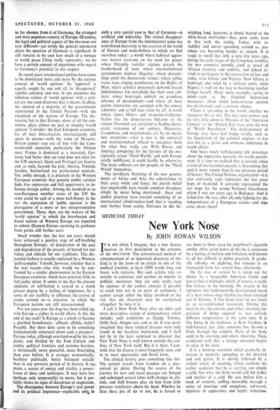New York Nose
MEDICINE TODAY
By JOHN ROWAN WILSON
I call it New York Nose after an older and more descriptive system of nomenclature which includes such conditions as Gyppy Tummy, Delhi boil, Aleppo sore and so on. It was never imagined that these tropical diseases were only found in the localities mentioned, and I shall not be in the least surprised to discover that New York Nose is well known outside the con- fines of New York itself. But it is there, I con- tend, that the disease is most frequently seen, and in its most spectacular and florid form.
The clinical history goes something like this. The patient travels from London on a pres- surised jet plane. During the course of the journey his ears and nasal passages are bunged and unbunged several times with changes in alti- tude, and chill breezes play on him from little pressure ventilators above his head. Whether he likes these jets of air or not, he is forced to use them to blow away his neighbour's cigarette smoke. After seven hours of this he is overcome by a feeling of malaise and irritation, well known to all but difficult to define precisely. It gradu- ally subsides on alighting, but remains in an attenuated form for several days afterwards.
On the day of arrival he is taken out for dinner by a hospitable American friend and gets to bed at midnight, which, of course, is really five o'clock in the morning. He awakes in the optimistic but fundamentally disorientated mood of a man whose sleep rhythm has been knocked out of balance. A few hours later he has lunch in an air-conditioned restaurant. During this meal he has the curious and rather alarming im- pression of being exposed to two entirely different temperatures at the same time. It is like being in the hothouse at Kew Gardens in mid-January just after someone has thrown -a brick through the window. Parts of his body seem to be sweating and others shivering. Then, associated with this, a strange sensation begins to arise in his nose.
It is a burning sensation which gradually in- creases in intensity, spreading to the pharynx and soft palate. It is shortly followed by a violent attack of sneezing, which confirms his earlier suspicion that he is starting, not simply a cold, but what the Irish would call the father and mother of a cold. He sees before him a week of torment, sniffing miserably through a series of meetings and receptions, red-nosed, repulsive in appearance and highly infectious.
He consults his American friends, all of whom insist that he must immediately take the latest anti-cold capsule. These capsules all tend to be based on a simple mixture of aspirin and an antihistamine (that is to say, anti-allergic) drug. He takes them out of politeness, but with con- siderable scepticism, since he can see no logical reason why they should work. Yet in twenty- four hours his cold has gone.
What is the explanation for this? A cold is a virus disease and virus infections do not clear up as quickly as that. Moreover, there is nothing in any of these capsules which could con- ceivably be effective against a virus. The only reasonable explanation is that this condition is not a cold at all. We are dealing here with some kind of sensitivity reaction, which in its early stages mimics a cold almost exactly. The capsules are effective because of the anti- histamine they contain.
As regards the exact cause of this sensitivity reaction, one can only theorise. It can hardly be pollen, since it occurs at all times of the year on an island almost barren of vegetation. A certain special quality in New York dust? Perhaps. But my own guess is that human mucous membranes were simply not constructed to deal with the violent changes in temperature and humidity to which they are now subjected by intercontinental travel and air-conditioning sys- tems. They protest in the only way they know how. And so it is that the citizens of Manhattan are rendered miserable by what they describe as head colds and sinus infections. This is why they stand gloomily in elevators groping for tissues and snorting like buffaloes. Meanwhile, the pill manufacturers make a fortune by marketing an effective remedy for a disease which has not even been described.
Well, it has been described now. I suppose one of these days it will be described again, in the proper manner, under the name of hyperbaric allergy or rhinitis transatlantica. But I prefer New York Nose. It has, one might say, a kind of ring to it. Another alternative did occur to me—but unfortunately there already is a Wilson's disease.



































 Previous page
Previous page